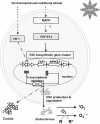Elsinoë fawcettii and Elsinoë australis: the fungal pathogens causing citrus scab
- PMID: 21199563
- PMCID: PMC6640467
- DOI: 10.1111/j.1364-3703.2010.00663.x
Elsinoë fawcettii and Elsinoë australis: the fungal pathogens causing citrus scab
Abstract
Elsinoë fawcettii and E. australis are important pathogens of citrus. Both species are known to produce red or orange pigments, called elsinochrome. Elsinochrome is a nonhost-selective phytotoxin and is required for full fungal virulence and lesion formation. This article discusses the taxonomy, epidemiology, genetics and pathology of the pathogens. It also provides a perspective on the cellular toxicity, biosynthetic regulation and pathological role of elsinochrome phytotoxin.
Taxonomy: Elsinoë fawcettii (anamorph: Sphaceloma fawcettii) and E. australis (anamorph: S. australis) are classified in the Phylum Ascomycota, Class Dothideomycetes, Order Myriangiales and Family Elsinoaceae.
Host range: Elsinoë fawcettii causes citrus scab (formerly sour orange scab and common scab) on various species and hybrids in the Rutaceae family worldwide, whereas E. australis causes sweet orange scab, primarily on sweet orange and some mandarins, and has a limited geographical distribution.
Disease symptoms: Citrus tissues infested with Elsinoë often display erumpent scab pustules with a warty appearance. TOXIN PRODUCTION: Elsinochrome and many perylenequinone-containing phytotoxins of fungal origin are grouped as photosensitizing compounds that are able to absorb light energy, react with oxygen molecules and produce reactive oxygen species, such as superoxide and singlet oxygen. Elsinochrome has been documented to cause peroxidation of cell membranes and to induce rapid electrolyte leakage from citrus tissues. Elsinochrome biosynthesis and conidiation are coordinately regulated in E. fawcettii, and the environmental and physiological inducers commonly involved in both processes have begun to be elucidated.
© 2010 The Author. Molecular Plant Pathology © 2010 BSPP and Blackwell Publishing Ltd.
Figures






Similar articles
-
Genetic dissection defines the roles of elsinochrome Phytotoxin for fungal pathogenesis and conidiation of the citrus pathogen Elsinoë fawcettii.Mol Plant Microbe Interact. 2008 Apr;21(4):469-79. doi: 10.1094/MPMI-21-4-0469. Mol Plant Microbe Interact. 2008. PMID: 18321192
-
Pathotypes and genetic relationship of worldwide collections of Elsinoë spp. causing scab diseases of citrus.Phytopathology. 2009 Jun;99(6):721-8. doi: 10.1094/PHYTO-99-6-0721. Phytopathology. 2009. PMID: 19453232
-
Draft Genome Sequences of Elsinoë fawcettii and Elsinoë australis Causing Scab Diseases on Citrus.Mol Plant Microbe Interact. 2020 Feb;33(2):135-137. doi: 10.1094/MPMI-06-19-0169-A. Epub 2019 Dec 6. Mol Plant Microbe Interact. 2020. PMID: 31577163
-
Current status and future prospects of grapevine anthracnose caused by Elsinoe ampelina: An important disease in humid grape-growing regions.Mol Plant Pathol. 2021 Aug;22(8):899-910. doi: 10.1111/mpp.13076. Epub 2021 Jun 7. Mol Plant Pathol. 2021. PMID: 34096145 Free PMC article. Review.
-
Phyllosticta citricarpa and sister species of global importance to Citrus.Mol Plant Pathol. 2019 Dec;20(12):1619-1635. doi: 10.1111/mpp.12861. Epub 2019 Sep 11. Mol Plant Pathol. 2019. PMID: 31512371 Free PMC article. Review.
Cited by
-
Physical Changes in Satsuma Mandarin Leaf after Infection of Elsinoë fawcettii Causing Citrus Scab Disease.Plant Pathol J. 2015 Dec;31(4):421-7. doi: 10.5423/PPJ.NT.05.2015.0086. Epub 2015 Dec 30. Plant Pathol J. 2015. PMID: 26674386 Free PMC article.
-
IMA genome‑F17 : Draft genome sequences of an Armillaria species from Zimbabwe, Ceratocystis colombiana, Elsinoë necatrix, Rosellinia necatrix, two genomes of Sclerotinia minor, short‑read genome assemblies and annotations of four Pyrenophora teres isolates from barley grass, and a long-read genome assembly of Cercospora zeina.IMA Fungus. 2022 Nov 21;13(1):19. doi: 10.1186/s43008-022-00104-3. IMA Fungus. 2022. PMID: 36411457 Free PMC article. No abstract available.
-
Transcriptome Analysis Reveals Candidate Genes for Light Regulation of Elsinochrome Biosynthesis in Elsinoë arachidis.Microorganisms. 2024 May 19;12(5):1027. doi: 10.3390/microorganisms12051027. Microorganisms. 2024. PMID: 38792856 Free PMC article.
-
Identification and Characterization of Diaporthe citri as the Causal Agent of Melanose in Lemon in China.Plants (Basel). 2025 Jun 10;14(12):1771. doi: 10.3390/plants14121771. Plants (Basel). 2025. PMID: 40573759 Free PMC article.
-
Six type-I PKS classes and highly conserved melanin and elsinochrome gene clusters found in diverse Elsinoë species.BMC Genomics. 2024 Oct 22;25(1):990. doi: 10.1186/s12864-024-10920-z. BMC Genomics. 2024. PMID: 39438784 Free PMC article.
References
-
- Adams, T.H. and Yu, J.H. (1998) Coordinate control of secondary metabolite production and asexual sporulation in Aspergillus nidulans . Curr. Opin. Microbiol. 1, 674–677. - PubMed
-
- Agostini, J.P. , Bushong, P.M. , Bhatia, A. and Timmer, L.W. (2003) Influence of environmental factors on severity of citrus scab and melanose. Plant Dis. 87, 1102–1106. - PubMed
-
- Ahonsi, M.O. , Boss, D. , Maurhofer, M. and Défago, G. (2006) Potential environmental fate of elsinochrome A, a perylenequinone toxin produced in culture by bindweed biocontrol fungus Stagonospora convolvuli LA39. Environmentalists, 26, 183–193.
-
- Aminian‐Saghafi, T. , Nasini, G. , Caronna, T. , Braun, A.M. and Oliveros, E. (1992) Quantum yields of singlet‐oxygen production by some natural quinoid fungal metabolites and derivatives. Helv. Chem. Acta, 75, 531–538.
Publication types
MeSH terms
Substances
LinkOut - more resources
Full Text Sources

